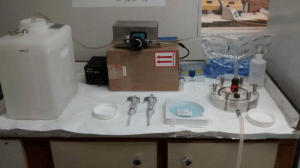As last year, scientists from the GreenEdge project are in the little village of Qikiqtarjuaq. Dozens of experiments are carried out at the ice camp. Here is an account of a new series of activities to evaluate the amount of organic matter that is exported from the surface to the bottom of the ocean.
In the first meters of the water column, enough light makes it through the ice to maintain an active primary production. This bloom is restricted to the first few meters of the water column and therefore, we may wonder how is it possible for organisms living at the bottom of the ocean to survive without food? Part of the answer resides in the amount of exported organic matter.
Our operations at sea and in the lab
To get an accurate picture of the export of matter from the top layers of the water column, large amounts of water are collected at different depths (ranging from 1.5 to over 100 meters) and processed once back in the laboratory. A first filtration allows us to recover the particles present in the water. These particles scavenge an interesting radio-element, the 234Thorium, which is naturally present in extremely small concentrations. Once all the particulate Thorium is removed, manganese chloride and potassium permanganate (see pink color on the main picture) are added and precipitate into manganese dioxide which traps the 234Thorium which was not already bound to particles. Once settled the manganese dioxide it recovered by filtering the water a second time. In addition to quantifying ratios of dissolved and particulate Thorium, 238Uranium from surface and 60m deep waters is also retrieved by precipitation and filtration.

Determining vertical velocities of the organic matter
After a quick transfer from the field to Bordeaux where the filters are analysed, 234Thorium and 238Uranium concentrations are determined using “g counters” in order to determine the vertical velocities of the organic matter. Since that in stable conditions, these two chemicals represent an equilibrium state, a lack of 234Thorium in the water collected from the top layers when compared to the concentrations of 238Uranium, therefore represent an export of particulate matter towards the ocean floor.
During the melt season, the algae developing at the ice-water interface are released in the water, and form aggregates that slowly sink away from the top. This experiment will allow us to have a better understanding of this process and estimate how much organic matter is available to organisms living deeper in the water column or at the bottom of the ocean.
Francis Dufour


